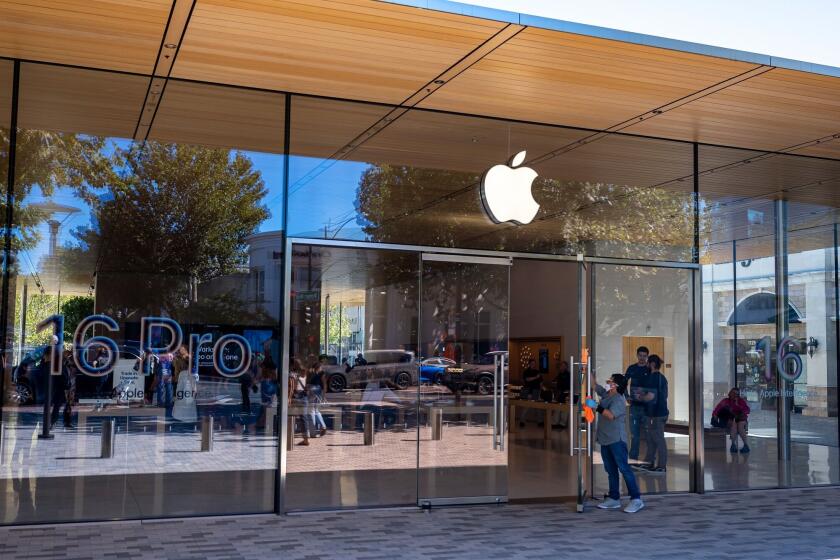Air Show Difficult to Get Off Ground
- Share via
SAN DIEGO — The only thing that Paris’ cosmopolitan Orly Field has in common with San Diego’s Brown Field are runways.
Brown Field, an under-utilized former Navy airfield with no regularly scheduled flights, is just a stone’s throw from the Mexican border and is used by Border Patrol agents in their attempt to stem the illegal flood of aliens that nightly passes by, and sometimes through, the field.
What Brown Field has--and Orly Field, home of the influential Paris Air Show, sorely lacks--is hundreds of acres of wide open space.
San Diego-based Air/Space America is hoping to grab enough American aerospace and electronics manufacturers to fill the sun-baked airfield and the skies above with an industry first: a U.S.-based, Paris-style international air and space show in May, 1988.
Despite widespread industry skepticism, Air/Space America, founded last year by retired 28-year U.S. Rep. Bob Wilson, hopes to draw hundreds of thousands of weekend spectators to a pair of spectacular air shows that will feature precision flying teams and an air armada that includes myriad U.S-built commercial and military airplanes.
Sandwiched between those spectaculars would be a Paris-style air show that Air/Space America believes would attract hundreds of air, space and electronics exhibitors and as many as 30,000 potential buyers.
The group’s goal has many industry experts shaking their heads. They point to aerospace industry belt-tightening, past failures in attempts to stage a U.S. air show and a proliferation of air shows elsewhere in the world.
“The chances of a successful show being put together in San Diego are about as good as me becoming Pope--and I’m not Catholic,” predicted H.G. Hollander, president of American Aerospace Industries, a New York-based marketing company that packages exhibits for companies at various international air shows.
“My guess it that it would be a very difficult thing for them to engineer a lot of enthusiasm in the aerospace industry, given the fact that there’s at least one major international show each year,” said another Doubting Thomas, a spokesman for Martin Marietta Corp. “I think that the industry in general . . . (is) not really favorable to adding another one.”
Air/Space America also has had internal problems. Last week, the organization’s president, Roger Tierney, resigned, citing “basic philosophical differences” on show management and funding.
Wilson nonetheless says he remains “encouraged” by Air/Space America’s progress. He suggested that Air/Space America, which has been “operating on up-front seed money,” is now “moving into the big leagues” in an attempt to attract the $25 million in sponsorships and affiliations he says is needed to produce the show.
Past attempts at establishing a U.S. show have failed, largely because manufacturers say they are already besieged by too many trade and air shows. In the U.S. alone, military contractors can display their wares at trade shows held by the Navy League, the Air Force Assn. and the Assn. of the U.S. Army.
New shows must compete with the Paris Air Show staged during odd-numbered years and the Farnborough, England air show held during even-numbered years. Last year, the Paris show, recognized as the world’s most influential, drew 1,000 exhibitors and 110,000 potential buyers, including 32,000 foreign buyers.
New shows in Singapore and Peking have drawn industry support, but exhibitors remain cautious because simply hosting a small booth at an international show can cost as much as $5,000. Transporting an airplane and staging a major marketing campaign can cost millions of dollars, according to industry spokesmen.
Aviation Week and Space Technology magazine dropped plans for a similar air show in Orlando during the early 1980s because “the industry didn’t think we needed another air show,” according to Aviation Week spokesman Bill Cockren. “The climate might have changed, but five years ago the aerospace industry just wasn’t interested.”
“The biggest . . . expense of all is the entertainment,” complained the vice president of new business development at one West Coast military electronics company. “The travel costs soar because (shows) are great places to party.”
Defense contractors are scrutinizing those costs in light of newly adopted federal acquisition regulations that prohibit contractors from passing along most air show costs to the armed forces.
“If the costs are not going to be reimbursable, then the money will be harder to come by,” said an executive at a major avionics manufacturer. “There have been a lot of cutbacks, and there is a squeeze on money available even for the existing shows.”
Should the San Diego show materialize, “it’s very unlikely that we would go all out for it,” said a spokesman for Lockheed Corp., which has cut back attendance at existing shows in order to curb costs.
“After each Farnborough and Paris show, there’s a period of time in which the worldwide industry wrings its collective hands and wonders why there has to be one show a year, every year,” said one major defense contractor executive who recently attended the Farnborough show. “Right now I’m too tired from Farnborough to even talk about another show.”
Still, if Air/Space America can “deliver the buyers, then the sellers will go to the show,” said Walt Rossbach, a Washington, D.C., marketing and advertising executive who has performed feasibility studies for both McGraw Hill (the owner of Aviation Week) and Air/Space America. “However, the biggest (aerospace) buyer is our own country, and it’s already well-served” by existing shows.
Air/Space America officials decline to say which exhibitors are likely to attend but Wilson said he has verbal commitments from “two top echelon Aerospace Industries Assn. companies.”
Several major companies with operations in San Diego seem interested in participating, among them Teledyne Ryan’s aeronautics and electronics divisions and Aerojet General.
Last week, Wilson suggested that Air/Space America could attract about 30,000 buyers during its six-day trade show session in May, 1988.
Air/Space America must meet a strict schedule if the show is to fly.
According to terms of a proposed lease with the City of San Diego, Air/Space America must spend $4 million to improve the field’s water, electric and sewage facilities. And it must provide amenities for the hundreds of thousands of spectators that the group hopes to draw during its weekend air shows.
Wilson wants to kick off the San Diego show with an hours-long aerial parade featuring representatives of every military and commercial aircraft manufactured in the U.S.
According to Wilson’s vision, hundreds of thousands of spectators would jam Brown Field for two consecutive weekends, drawn by a stunning air show featuring precision flying and parachute teams from the United States, Canada and other countries.
In keeping with the Paris Air Show model, Wilson is building Air/Space America around a proposed six-day trade show for U.S. aerospace and electronics manufacturers, featuring a gaily decorated tent city, housing corporate chalets and an indoor display area.
“It comes back to whether or not they can attract the buyers,” Rossbach said. “And if they can attract the buyers, the sellers will be there.”
In November, Air/Space America will petition the U.S. Commerce Department to designate the show as one of 15 trade shows to benefit from the department’s “foreign buyer program.”
To gain department backing, Air/Space America must “demonstrate that (buyers and sellers) will go for a first-time show . . . because first-time shows are a very risky business,” said David Earle, director of events promotion in the department’s U.S. and Foreign Commercial Services Division.
The U.S. government does not provide financial backing but it does give “a seal of approval . . . a philosophical endorsement that this (fair) is a good one,” Earle said.
As important is the access to 65 Commerce Department offices around the world that would help “drum up interest” by matching potential foreign buyers with domestic manufacturers.
Air/Space America also has begun the search for potential sponsors and affiliates that Wilson is counting on to help finance the show.
However, it is not likely that Air/Space America will forge a relationship with the influential Aerospace Industry Assn. The Washington, D.C.-based organization, which represents the nation’s major aerospace manufacturers, has never endorsed an air show, preferring to leave that decision to its members.
Air/Space America has drawn interest, however, from the 3,500-member American Electronics Assn., according to John Baumeister, vice president with the Palo Alto-base organization, who has met informally with Wilson.
“I’m very enthusiastic about the San Diego show,” Baumeister said. It’s logical for the U.S. to have an air show. And in my opinion, the ingredients (in San Diego) appear to be right.”
San Diego’s key ingredient is Brown Field, the under-used former Navy field that enjoys perfect flying weather in May. Because Brown has no regularly scheduled flights, it could easily absorb the 10-day show, according to Wilson.
Brown has easy access to thousands of nearby hotel rooms and Wilson is counting on Southern California to provide the hundreds of thousands of air show attendees needed to cover part of the show’s costs.
Wilson predicted that Air/Space America’s “unique” blend of air, space and electronics exhibits would be particularly attractive to Pacific Rim buyers now gaining importance, according to U.S. manufacturers. Wilson also hopes to develop working relationships with West Coast military bases where exhibitors’ products are being used.
Air/Space America would be competing with the the show in Singapore that, although it does not feature in-air exhibits, seems to have attracted enough industry support to continue.
Air/Space America might displace that Far East show if it can deliver buyers from “the Pacific Rim countries where we’re seeing a heck of a lot of interest in avionics,” said Teledyne Ryan Electronics President Robert Steenberge.
Despite Wilson’s optimism, one industry observer suggested that the proposed show must be viewed “with a careful eye as to who would be attending and the benefits we could derive from participating.”
“If this (show) were anywhere other than San Diego, I’d agree that it wouldn’t work,” Wilson said. “But we’ve got the field, the hotel rooms, San Diego, Mexico, defense and electronic people and a proximity to the Pacific Rim.”
More to Read
Inside the business of entertainment
The Wide Shot brings you news, analysis and insights on everything from streaming wars to production — and what it all means for the future.
You may occasionally receive promotional content from the Los Angeles Times.










